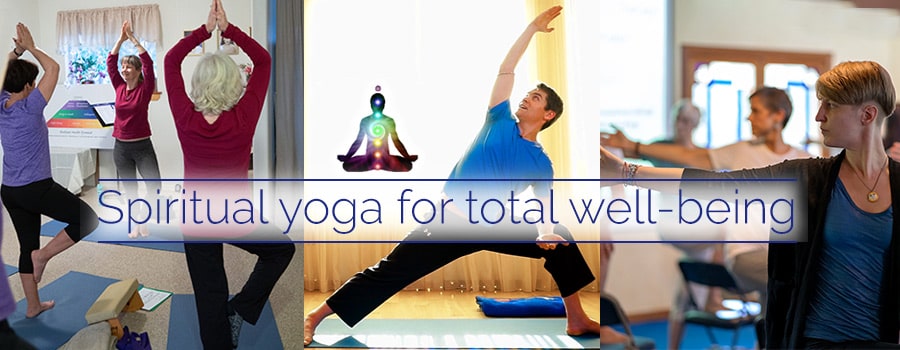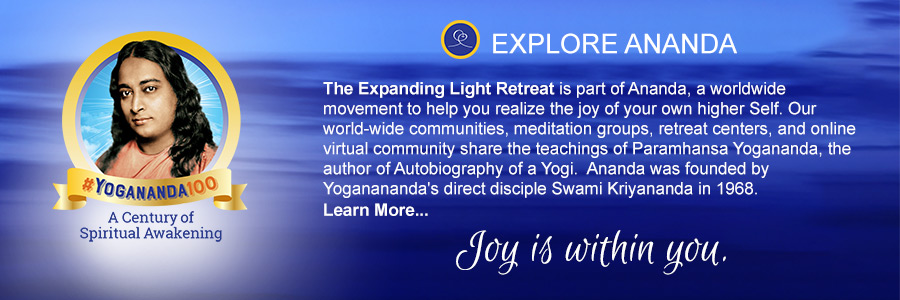Keepin’ It Simple
Earlier this year, I received an e-mail from a relatively new Ananda Yoga Teacher Training graduate who had just begun teaching Ananda Yoga®. In part of the message, this person wrote, “I don’t know what in the world ever made me think that I could do this. Ananda Yoga is so complex.” I enjoyed the humor and the humility, but I was also a bit surprised.
After all, this person is a very accomplished hatha yogi who had already been teaching yoga for many years before Ananda Yoga Teacher Training.
And the spiritual dimension of Ananda Yoga was not new, because this person is a real yogi, a long-standing devotee for whom the spirituality of yoga was a given. All in all, I thought that teaching Ananda Yoga would seem fairly straightforward for this teacher.
The Whole is Greater Than the Sum of Its Parts
Yet I can understand how teaching Ananda Yoga can seem a bit overwhelming in the beginning. Because our ultimate goal is spiritual, we are dealing with some aspects of the practice (energy, states of consciousness) that are not as concrete as the body. Teaching students to work with this is harder than, say, telling them where to put the left foot.
In addition, there are a lot of separate “pieces” to teaching Ananda Yoga: contraindications, safety issues, alignment, clear language, conscious movement, breath awareness, energy movement and control, states of mind, and oh yes, the affirmations. (“Hmmmm, is it ‘give me peace’ or ‘bring me peace’?”)
Plus the silent periods after the teacher offers the affirmation. And the Sanskrit names of the poses. And all the differing individual needs of the students. And as if that weren’t enough, we’re also supposed to be inspiring the students in some way? Whew!
It’s like learning to drive a car that has a manual transmission. You have to think about pushing in the clutch, shifting gears, using the turn signals, looking back through the rearview mirrors, turning the steering wheel, checking the speedometer, looking ahead at oncoming traffic, etc. In the beginning, it’s very complex.
And so it can seem with teaching Ananda Yoga if we look at it in terms of all its parts, all the details to remember.
How in the world can we do it all? Is it a race to see whether we can say everything that we need to say before the students collapse out of the poses from sheer exhaustion?
The image that comes to mind is that of the performer on one of the old television variety shows (anyone remember “The Ed Sullivan Show”?), who would set a number of dinner plates spinning, each atop its own tall, skinny, wooden pole. Then he or she would spend the rest of the “act” racing back and forth among the plates as first one, then another, then another would begin to wobble, in danger of falling to the floor and breaking.
The performer would barely manage to save one plate from its demise by setting it spinning once again, then race to another pole to save the next endangered plate, and so on. All the time the audience would be shouting “Look out! Get that one! Aaaach!” It was fun to watch, but also quite nerve-wracking.
We certainly don’t want our Ananda Yoga classes to be like that, for ourselves or our students. So we have two choices: we can toss overboard some components of Ananda Yoga in an effort to make it simpler, or we can find simplicity in Ananda Yoga “just the way it is.”
I’m sure you know that I don’t recommend the former (although certainly you’re not going to emphasize every component in a beginning class), so let’s talk about the latter. I’d like to offer three keys to finding simplicity.
First, and most obviously, teaching experience is vital. Just like driving a car with a manual transmission, we soon become familiar with the mechanics and we develop our own natural styles as teachers. Then we find much greater ease and more flow to our teaching, and we can relax into it. Nothing mysterious about this.
Making the Poses Your Own
The second key is to experience for yourself what makes each pose “tick.” Underneath all the mechanics and alignment, what is really going on in the pose? How does the energy move? What is its effect on the mind? In short, what is the overall feeling of the pose? Once we tune in to that essential feeling, the remaining aspects of the pose follow fairly easily. (More on that in a moment.)
Why? Because we see how the physical pose is, at a deeper level, simply an outward expression of the feeling. The more we get into the feeling, the more the physical pose unfolds from inside us. Everything ties together in one neat package — alignment, energy, states of mind, everything. And that package is called, “feeling.”
That’s why I often characterize Ananda Yoga as a heart-based practice: the heart chakra is our primary instrument of feeling. I’m speaking not of emotional feeling, but of chitta, the intuitive foundation of our consciousness, to which Patanjali refers in his second sutra (and many others as well): Yogas chitta vritti nirodh, “Yoga is the neutralization of the vortices of feeling.”
Only when we touch that “feeling place” inside us during an asana are we really doing the pose. Everything else — alignment, breath, etc. — is just preparation. How can we experience that essence? Unless we can meditate very deeply on the asana, I think there’s only one way to tune in to that essence: through our own experience of the pose. It won’t come through thinking, reading, or hearing about the pose — or even from doing it, if our “doing” is just on a physical level. It has to come from deep inside us. We have to make the pose our own.
I’ve told many of you about the worst class I ever taught. It was a great lesson — for me, not (unfortunately) for the students. I gave what I hoped was a solid exposition on an interesting topic (in fact, the students had chosen the topic).
I figured I would be safe in basing my talk on the ideas Swami Kriyananda, who is without doubt an expert on the subject. However, I made the mistake of doing this without having dived deep into the subject myself. I knew the teaching, but I hadn’t really experienced it.
It was dismal. I remember thinking, “Gee, the students don’t seem very engaged. Come to think of it, even I don’t find this class interesting.” I’d prepared diligently, organized my notes, figured out exactly what I was going to say and when I was going to say it — but I’d left out one vital step: I hadn’t made it my own, I hadn’t lived it.
Had I done so, I could have said the very same words with a much different result: the class could have been both informative and inspiring. Why? Because my own understanding would have shone through the words. Words are just the vehicles for the underlying vibration of our own understanding. They infallibly carry our understanding — or lack of it.
So it is with teaching Ananda Yoga. We must offer our students, through our instructions and demeanor, the vibration of each pose. And we can only do that when we’ve already experienced that vibration, made the pose our own.
There is an Ananda Yoga Teacher Training class in which the students spend a lot of time in just a couple poses, going deep into the inner experience, then come out and drew pictures of your experience with crayons.
Many students say, “Wow, this is so cool! I can really feel what’s going on inside when I do the asana.”
Well, have you done that “research” with all the poses that you teach? Have you ever done that with even one pose?
It’s easy to get so focused on the details of teaching that we forget to lay the foundation for all of it. We think we can’t afford to spend a big chunk of our precious personal practice time on “just one pose.” The truth is, we can’t afford not to do it. I urge you to do this exercise (or something similar) for each pose you teach — yes, even Tadasana.
A Unifying Element
The third key is simply the practical implementation of the second. When you know the essence of the pose — or at least part of the essence — you can use it to unify all the other aspects of the pose. It’s as though that essence were a thread; teaching all the other aspects of the pose is like stringing beads on that thread.
For example, suppose you’re teaching Trikonasana and you want students to experience the dynamic openness and receptivity that the pose promotes.
Then emphasize that from the very beginning of the pose: “Step your feet wide apart and turn your left leg out 90 degrees. Feel the openness through your inner left thigh and hip. Turn the leg back in — notice the difference? Okay, now turn it out again. Let’s do this pose in such a way that we experience that openness throughout the body — and let’s not do anything that decreases that openness.”
And so it can go, opening through the other hip, the pelvis, the torso, the shoulders, the face, the breath, etc. You don’t have to be tedious about it; just carry the theme of openness through the pose.
Then your teaching will flow very naturally, and everything you ask the students to do will in some way help them deepen their experience of the pose. When all is in readiness and you offer the affirmation, inviting them to take it inside, they will resonate with it because they’re already feeling it.
In the ensuing silent time, it will feel entirely natural to practice the affirmation, and they’ll feel even more energy and joy flooding their body cells. Then it becomes their own experience, their own higher awareness. And that’s what Ananda Yoga® is all about.
Simple, isn’t it?
All authors are graduates of Ananda Yoga Teacher Training.





















